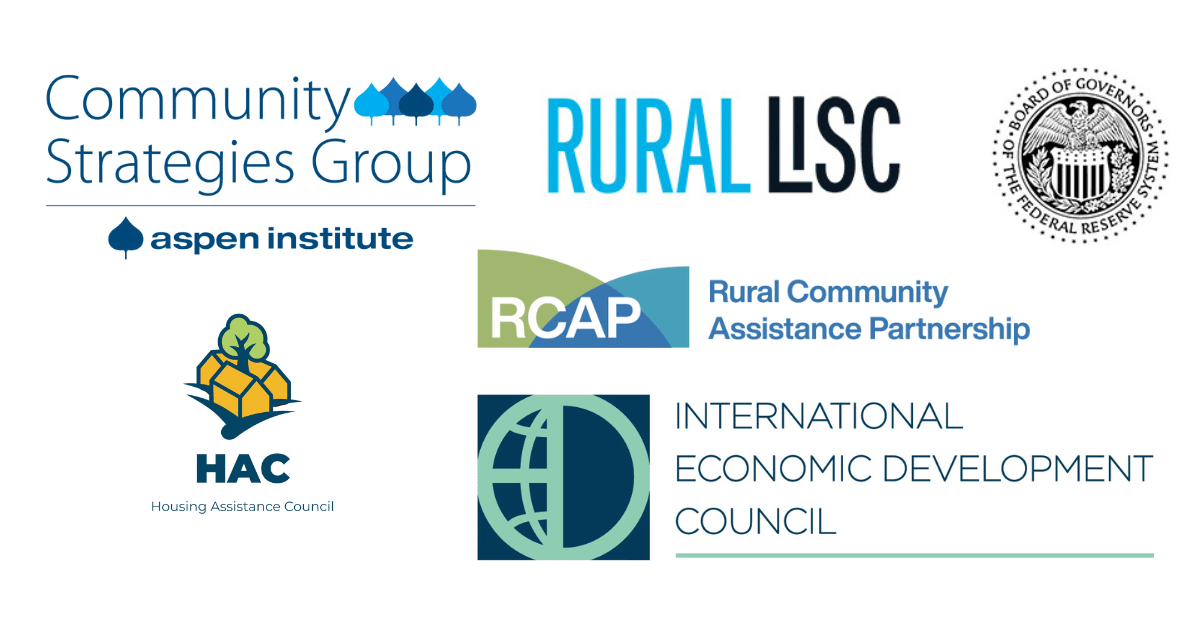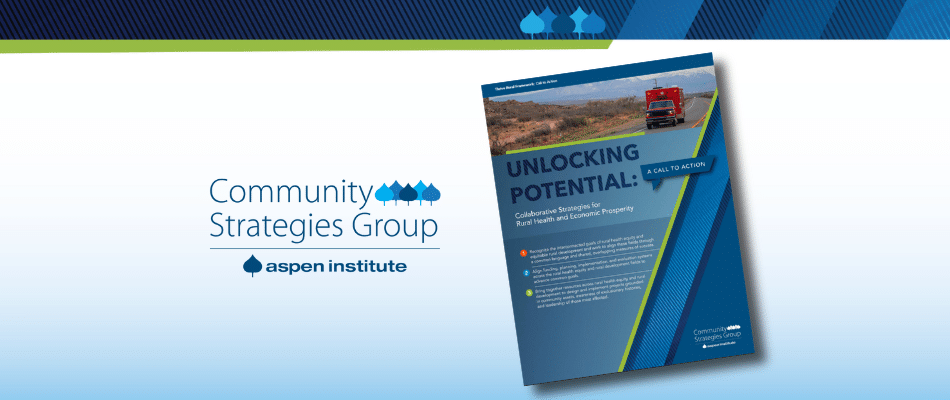With rural’s wide geographies and low population densities, it can be challenging to coordinate complex health equity and economic development efforts across rural regions. Rural and Indigenous communities need formal and informal mechanisms that enable local people, agencies, and groups to work together across interests and across regions, plan wisely, and access and take advantage of opportunities. That means having organizational structures and networks for shared community planning and development, strong partnerships, and the capacity to receive and pool funds from multiple sources.
So what does it take to organize a regional action infrastructure? How are rural organizations and local leaders strengthening regional networks and working across communities? How are new networks and relationships helping to take advantage of new opportunities? How are equity, fairness, local ownership, and better health outcomes informing those efforts?
These questions grew from Aspen CSG’s work on the Thrive Rural Framework. To explore some answers, Bonita Robertson-Hardy, Aspen CSG’s Co-Executive Director, recently facilitated a virtual discussion of 75 rural leaders with all levels of experience. The ideas and most of the resources shared in this blog arose from this wide-ranging conversation that included a networking bulletin board. Aspen CSG does not necessarily endorse these resources, but we look forward to exploring them with you.
Action Infrastructure Runs on Complex Reciprocity
Participants shared how complex reciprocity is critical to network success. Rich Pirog and Marcus Coleman, authors of Aspen CSG’s recent research brief, Using Networks to Build Collaborative and Equitable Food Systems, related how complex reciprocity is at the heart of all of the successful local food networks they have experience with. Reciprocity is the quality of an act, process, or relationship in which one person receives a benefit from another and, in return, provides an equivalent benefit. The complexity part comes in when reciprocity is stretched over time, where one network partner provides a benefit and trusts that, over time, that benefit will be repaid by other network members. This mutually beneficial relationship among partners relies on strong bonds of trust.
How to build and maintain trust was a central topic of conversation. Participants identified three core components to building regional network trust that helped grow, strengthen, and maintain strong bonds across time and geography.
- Be attentive to who’s NOT at the table and work to bring them in. This principle of inclusion is important for building trust across a network that may have very different members from different parts of a region. It also appears in one of the Thrive Rural Framework building blocks, Welcome All to the Community. In order for communities to achieve their full potential, each and every person must be invested in community success and consider themselves represented in decision-making for the community. This requires that the community consistently identifies and addresses impediments to participation, including transportation, education, health, and timing, among others – and that it removes any discriminatory barriers to participation based on personal characteristics such as socioeconomic class, gender, identity, race, country of origin, religion, or place of residence.
- Ensure transparency and communication with members and communities. Open and honest lines of communication are crucial to maintaining trust within a network. Whether that’s through regular meetings with updates, personal phone calls, public meetings, or other methods, the sharing of information helps everyone be informed of consequential decisions and feel valued. This is highlighted in the Thrive Rural Framework building block, Aligned Rural Fields and Actors. To advance equity for rural people and places, rural advocates must be coordinated. Rural single-issue and proprietary interest groups need to learn more about and from each other, share resources and expertise across their fields and niches, recognize the interconnectedness and interdependence of their issues, and learn about how their individual efforts help or harm other rural interests.
- Find ways to maintain excitement and participation from members and communities. Much of the equity and prosperity work underway in rural places is hard, long-term work, and keeping up the momentum of a coalition over time can be challenging. That’s why participants suggested continuing to celebrate small wins and, as the network grows and develops, continue sharing stories of success, celebrating wins, and maintaining strong personal relationships among members. Build Momentum is a Thrive Rural Framework building block that examines this issue. Every rural community is different, with different mixes of assets – and different starting points. Especially in rural communities that have been struggling, it is tactically important to select issues and actions that can produce visible wins, even if small, that can inspire new energy, ideas, capacity-building, and participation that builds into steady progress.
Shared Resources on Action Infrastructure
Participants shared these ideas and resources during the event; we have curated them below in hopes they will be useful in your endeavors to organize an action infrastructure in your region.
- In Aspen CSG’s recent research brief, Using Networks to Build Collaborative and Equitable Food Systems, authors Rich Pirog and Marcus A. Coleman focus on local food systems as vehicles for collaboration and racial equity among multiple stakeholders and networks.
- Building infrastructure in small communities requires broad networks of mutual learning and support. Aspen CSG partner Marcus A. Coleman shared the success of the Wallace Center’s Food Systems Leadership Network, which he attributes to the sustainable funding dedicated to maintaining connections and the networking process.
- Participants discussed the proven value and effectiveness of the DCSEU Workforce Development Externship Program, which educates DC residents on the fundamentals of the solar and energy efficiency fields and places them as ‘Externs’ with DC-based solar companies for 3-5 months.
- One tool participants shared was helpful for their network-building work was Emerald City’s The People’s Justice40+ Community Benefit Playbook. This guide to capturing federal infrastructure investments offers frontline groups and community organizations guidance and works to ensure that federal infrastructure and climate investments significantly benefit the communities that need them most.
- Participants shared the work of Bastrop County Cares, a nonprofit organization and county-wide partnership working to develop comprehensive community initiatives by identifying community priorities, collecting and analyzing data, and bringing together collaborative partnerships that will result in community solutions.
- The Continental Divide National Scenic Trail (CDT) connects communities along a thriving landscape of unique and precious ecosystems. The trail acts as an unconventional and vital network facilitator and a meeting ground where people from many different communities can come together.
- Food & Society at the Aspen Institute brings together public health leaders, policymakers, researchers, farmers, chefs, food makers, and entrepreneurs to find practical solutions to food system challenges and inequities.
- The program, working with its expert Food is Medicine Advisory Board, published the Food is Medicine Research Action Plan that establishes concrete steps to build on existing efforts and engage new actors, advancing research across the full spectrum of interventions, from prevention to treatment.
- Food & Society also hosts a virtual live webinar series, Conversations on Food Justice, in which they bring a diverse panel of experts and people with lived experience to discuss different challenges in the food systems within their communities.
- Based on the region-wide mission to lift 1,600 children and their families out of poverty by 2025, Empower Upper Cumberland comprises many key regional partners that collectively work to streamline services that are already available, as well as provide new economic resources and services for community members.
- The Northwest Colorado Development Council is a coalition of three districts in Northwest Colorado working to collectively tackle regional issues and work together to spur economic and community development.
- New Growth, a West Central Missouri community development corporation particularly focusing on lending and credit building food systems, workforce development, and transportation.
- The Access for Rural Community Health Coalition (ARCH Coalition) is an alliance of over 30 health and community service-based organizations in Hopkins County in western Kentucky. ARCH Coalition works to bring together and support all organizations that contribute to the health and wellbeing of western Kentucky with the goal of helping Hopkins County and rural communities everywhere become healthier and more prosperous places.
Devin Deaton, Action Learning Manager with the Aspen Institute Community Strategies Group, and Ava Partridge, Aspen CSG’s Summer Intern, worked together to curate this learning reflection. Open Field sessions inform and are informed by Aspen CSG’s Thrive Rural Framework, a tool that aims to help communities and Native nations across the rural United States become healthy places where each and every person belongs, lives with dignity, and thrives. To join the next Open Field session, register for our mailing list.






